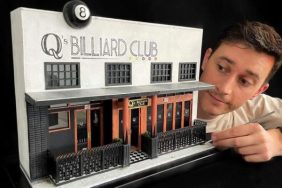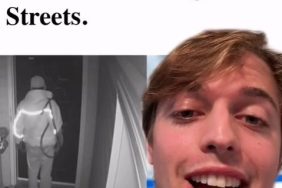Artwork: Alex Gross. Detail from “Suspicion”. Oil on canvas, 35 x 48 inches.
Los Angeles painter Alex Gross has mixed feelings about social media. While it functions as an effective platform for sharing artwork, it’s also a cultural obsession so all-consuming that people don’t seem to connect with one another in the ways that really matter anymore. The artist contemplates the benefits and drawbacks of our tech-centric society in his new exhibition “Antisocial Network”, opening on Feb. 25 at the Corey Helford Gallery. About half of the full-size paintings, drawings, and cabinet card paintings in the show focus on humans in relation to technology, particularly electronic devices. While Gross’ settings are often radiant with color, his subjects bear bleak, sullen expressions. The overall effect is incredibly sad, and will hopefully inspire you to put down your smartphone more often.
We asked Gross about the sinister side of technology and his renowned surrealist style.
Crave Online: What themes do you see emerging in the “Antisocial Network” exhibition?

Artwork: Alex Gross. “Mirror (after Tooker)”. Oil on canvas, 23.25 x 19.5 inches.
Alex Gross: That’s a big question. We’re all on social media too much. People are always not present, looking at their device. Even though it’s social in a way and we have these online friends that we would never have in the real world, it’s also kind of anti-social because you go out for coffee or beer with your friends and everybody’s kind of ignoring each and on Instagram half the time. About half the work in this show is dealing with those issues. The other half of the work doesn’t necessarily have technology in it, but I do think thematically it’s pretty consistent because most of the people I paint are sort of…what’s the word? Not completely present. They might be looking off [or have] a blank expression. I’ve got one woman who’s just floating in the bath; she looks like she’s almost comatose. I feel like the consistent emotion throughout all the work is that lethargic…what’s the best word? Lack of really being present.
And yet, you juxtapose that listlessness—
Listlessness. Yes. That’s a good word.
You juxtapose that with these bright colors.
I’m not necessarily trying to be really colorful in most of the work. I’m not trying to make depressing work. If some of the images were painted with a really drab palette, they might feel darker and more depressing than they do than if they’re colored more brightly. I feel like most of my color palette is pretty realistic, but I have heard from several people that my colors are really intense.

Artwork: Alex Gross. Detail from “Sunday in the Park with Reptilians”. Oil on canvas, 57.5 x 50 inches.
It also seems like you paint more female than male subjects.
It’s true. I keep trying to paint more men. I have one piece in this show that’s only men in it and then I have about three pieces that have a woman and a man, and then I have one piece that has a lot of men’s heads, but they’re disembodied. I like to paint women more, but it’s not for any conceptual reason that I’m doing it. It’s just easier for me to find women that I want to photograph and paint than it is to find men. Most of the men I know are old like me and I definitely like to paint younger people.
Also: Artist Profile | Carlos Rolón: Nostalgic Bling
Why do you include branding and logos in your artwork?
In this show, there’s very little branding or logos. People buy things and they’re carrying the bag that has the logo on it or they’re in a city where there are billboards and bus signs everywhere. I just feel like it’s a natural part of our environment, unless you live out in the mountains somewhere. I just show the natural part of our contemporary urban or suburban reality.

Artwork: Alex Gross. “Monogatari”. Oil on canvas, 41 x 41 inches.
Yet there’s also a dreamlike quality to your work, a surrealism about it. One piece has a woman riding a lion over a bunch of fast food signs. It’s almost fairy-tale-esque. Where does that influence come from?
It’s funny that you said “fairy tale”. I almost called that piece “Fairy Tale”. It’s called “Monogatari”, which is a Japanese word that means “like a story”. Kind of like a fairy tale, but not specifically a kids’ story. I wanted to make a fairy tale image with a little bit of reality sprinkled in.
A lot of the work in this show is more realistic than surrealistic. I’m a little bit schizoid. I feel like I’ve got two sides as a painter. One side likes to paint pretty realistic imagery ‘cause I shoot a lot of models for reference and I like to do that. And then the other side of me, and where I come from as an artist, is the more surreal. I feel like there’s a bit of a split in the show.
In “Shopholics II” you painted women with animal heads. Can you explain that?
No, I’m not going to explain it. I’ll let you speculate on that. That image is similar to another painting I did called “Shopaholics” about three years ago which also had people that had sheep heads. That’s another one that’s pretty surreal. I like people to bring their own inquisitive process to stuff like that. If I say, “I made them sheep because of X,” I feel like it robs people of the pleasure of their own interpretation.

Artwork: Alex Gross. “Shopaholics II”. Oil on canvas, 42 x 42 inches.
What about the snakes in that painting? There are three of them on the ground. Are those symbolic in some biblical or sinister way?
I think it’s pretty easy to interpret snakes as danger or evil. I don’t think too many people see an image of a snake and think anything nice. So, yeah, I think in that image they represent peril or hazard.
Would you say you’re pessimistic about the future of American culture given social media and its impact?
Right now, it’s much more politics that are bumming me out than social media. Most of us, I think, have mixed feelings about social media. Especially for an artist, social media is a great tool to have. Ten or 15 years ago, it would be impossible to have hundreds of thousands of fans be kept up to date on what I’m doing every week. I’ve discovered all kinds of interesting artists and other creative people through social media.
At the same time, I’m sure many of us have been in a situation where you almost run somebody over when you’re driving because they’re walking across the street staring at their phone and it’s frustrating. I feel like technology, the internet, it’s got so many amazing aspects to it and the flip side of the coin is it’s easy to waste your time web-surfing all day and not get anything done. I’m very ambivalent about all kinds of technology, including social media. I’m a bit pessimistic about the future of the planet and human nature.

Artwork: Alex Gross. “Contemplation (Slurpee)”. Oil on canvas, 42 x 32 inches.
Does that pessimism ever prevent you from creating or does it fuel your creativity?
It totally fuels what I do. Doing my work is my outlet for all of my strong feelings. If I wasn’t an artist, I don’t know how I would get this stuff out. Political stuff is a little more challenging. I don’t make specifically political imagery like someone like Shepard Fairey does, which I admire. Sometimes, I’d really like to. I’d love to make a great anti-Trump image that resonated with millions of people because I’m very opposed to him and what he stands for. I have done some work that parodies political figures, but that’s not exactly my niche. Sometimes there’s still strong feelings about stuff like that don’t necessarily get an outlet through my painting. But my painting is my voice. I feel like I’m doing something worthwhile when I make a piece and show it to people.
What do you hope viewers of “Antisocial Network” take away from the exhibition?
I just hope that my paintings might resonate with people. If there’s a piece that has technology in it and it makes people think, “Hmm, maybe I’m a little too obsessed with my phone,” that’s cool, but that’s not my goal. If there’s other imagery that they respond to that doesn’t have technology in it and it makes them think about life and death and the meaning of life and all that big stuff, that’s cool, too. If they think, “That’s a really interesting image and I wonder what it means,” that’s great, too. All of the above are fine with me.
The only thing I want to do is engage people. If people come look at my work in person and they don’t find it interesting and can look at everything in 10 seconds, then that would be a disappointment to me. I just want to engage people, and make them look, and hope the looking makes them think.





